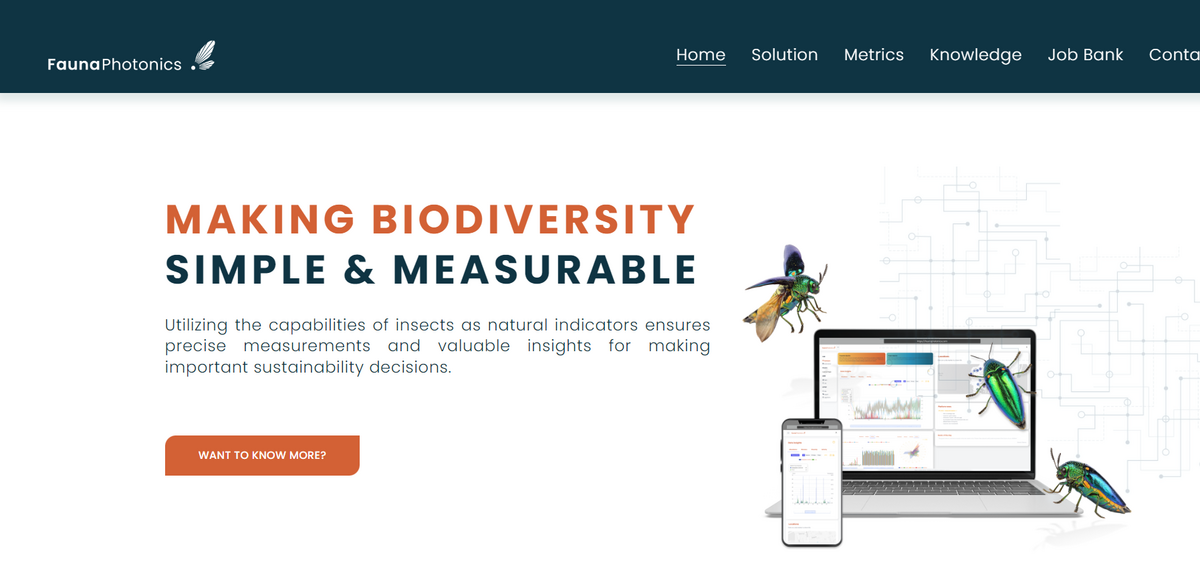What the Project Is
evolito transforms biodiversity into actionable insights that build trust, improve transparency, and create tangible value across industries. This innovative initiative spans Renewable Energy, Agriculture & Food, Nature Restoration, Forestry, Technology, Science, Knowledge, and Company sectors. It is aligned with leading global biodiversity frameworks like TNFD, CSRD & SBTN, which lends credibility and confidence to its mission. At its core, the project leverages cutting‐edge sensor technology to continuously monitor biodiversity. Simultaneously, FaunaPhotonics is building next generation, real-time insect monitoring technology that supports integrated pest management, timely treatments, and intelligent spraying equipment—filling crucial gaps in knowledge of insect populations and leading to more sustainable agricultural production. With a harmonious blend of evolito’s comprehensive biodiversity insights and FaunaPhotonics’ patent-protected sensor technique, the project paves the way for clearer, science-based decision-making in diverse ecosystems…
Main Benefit: Key Figures and Facts
The benefits of this project are not just conceptual—they are measurable, impactful, and tailored to modern compliance needs. Key figures and facts include:
- Innovative Biodiversity Uplift Metric: Measuring seasonal change and impact in natural ecosystems.
- Actionable insights that empower industries to validate positive biodiversity initiatives, strengthening stakeholder trust.
- Continuous monitoring via evoSense sensors, capturing baseline insect data and habitat benchmarking.
- Alignment with TNFD, CSRD (ESRS E4), EU CRCF, and various permitting guidelines for clear compliance pathways.
- Rapid sensor deployment, including solar-powered sensors designed for renewable energy sites.
Habitat Assessment and Project Design
Insect monitoring and biodiversity insights start at the ground level. Specialists conduct habitat assessments that evaluate habitat condition, ecosystem connectivity, and key environmental variables—factors crucial for understanding natural ecosystems. Meanwhile, project design is a collaborative process, tailoring biodiversity decision intelligence programs to meet specific objectives. This includes optimizing project parameters so that biodiversity data can effectively guide strategic decisions. With the support of advanced sensor technology, customers can integrate biodiversity assessments into their projects in a way that validates sustainability claims and directs meaningful action…
Continuous Monitoring and Data Insight
The evolution of data insight in biodiversity monitoring is powered by a sophisticated analytics platform that draws on artificial intelligence and proprietary algorithms. Insect signals—captured with precision from continuously deployed evoSense sensors—are transformed into comprehensive biodiversity insights. These insights provide a detailed snapshot of habitat health at various project sites, accessible through the evoInsights portal. With time-stamped, geo-referenced, and scientifically validated data, environmental impact measurements can be tracked over time. The approach is straightforward, dynamic, and tailored to support integrated pest management and sustainable crop production. It’s like having a live pulse on nature, which makes managing biodiversity risks and aligning with ESG frameworks a far more confident exercise.
Insect Signals and Ecosystem Health
Insects play a pivotal role in indicating the health of ecosystems. Their activity serves as a living indicator of biodiversity change. By harnessing automated insect monitoring, the project offers businesses clear, scientific evidence to support informed decision-making. This technology bridges the gap between raw data and actionable insights, helping to mitigate ecosystem risks. Whether it is monitoring the impact of renewable energy projects on ecosystems or supporting sustainable practices within agriculture, the insect signals are integral in showcasing seasonal change and ecosystem vitality. It resonates on a basic, almost natural level, as insect behavior is both a subtle and comprehensive measure of environmental health.
Technological Innovation in Biodiversity Monitoring
Emerging technologies like the evolito and FaunaPhotonics platforms combine light-associated information with machine learning algorithms to differentiate among insects—delivering real-time, dynamic data. This patent-protected sensor technique affords precise measurements, ensuring that biodiversity metrics are not only reliable but also detailed enough to guide sustainable practices. The integration of sensor technology with AI provides audit-grade data, ideal for supporting green finance instruments such as sustainability-linked financing and green bonds. This intersection of technology and ecology marks a significant advancement in how biodiversity is monitored, making complex environmental trends easier to understand and manage.
Project Impact on Sustainable Development Goals (SDGs)
- SDG 2: Zero Hunger – by supporting sustainable agriculture through integrated pest management and crop monitoring.
- SDG 7: Affordable and Clean Energy – by ensuring renewable energy projects operate with minimal impact on biodiversity.
- SDG 9: Industry, Innovation, and Infrastructure – through the development and deployment of next-generation monitoring technology.
- SDG 13: Climate Action – by providing reliable data that informs adaptive strategies to climate change-related risks.
- SDG 15: Life on Land – by preserving and restoring ecosystems through targeted biodiversity monitoring and protection initiatives.
Future Directions and Integrated Decision-Making
Biodiversity monitoring today is all about proactive management and continuous learning. The constant flow of real-time data means that organizations can respond, adapt, and even predict changes within natural ecosystems. By combining the strengths of evolito’s sensor-based insights with FaunaPhotonics’ insect monitoring, the project paves the way for a future where businesses, regardless of industry, have robust methodologies for sustainable operation. The approach remains centered on science, transparency, and measurable progress—not just momentary compliance, but lasting change. In this evolving landscape, data is more than numbers; it is the foundation for building trust, enhancing decision-making capabilities, and ultimately, supporting the planet’s biodiversity in a tangible way…





















